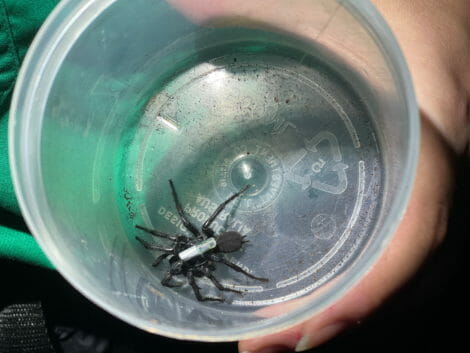
A male Sydney funnel-web spider with a telemetry tracker attached waits in a container to be released back into the bushland by Caitlin Creak, PhD candidate from the School of Biological Earth and Environmental Sciences at the University of New South Wales, in Sydney, Australia February 18, 2022. REUTERS/Jill Gralow
SYDNEY — Some Sydney funnel-web spiders are scrambling into the Australian brush carrying special cargo: a telemetry tracker to study how far a mature male can travel at night and whether their movements are affected by the environment and weather.
Caitlin Creak, a PhD candidate at the School of Biological, Earth and Environmental Sciences of the University of New South Wales, has been tracking the male Sydney funnel-web, one of the world’s deadliest spiders, for two summers. The nocturnal arachnid lives within around 100km (62 miles) of Australia’s largest city and is mostly active between November and April.
Having grown up in Australia’s bushland, the 27-year-old is no stranger to spiders, but her love for them grew after she learned about them during her biology degree, and interacted with the creatures she thinks are wonderful.
Most studies on the Sydney funnel-web spider are about its venom and taxonomy, but Creak’s study focuses on its behavior and ecology.
“The Sydney funnel-web has a human-lethal venom, which is just a bit of an evolutionary coincidence, as we suspect at this stage,” she said. “That’s kind of all we know about them to be honest. We don’t actually really know anything else in terms of their behavior, their biology or their ecology.”
To be able to attach the tracker, the spider must first be knocked out with carbon dioxide, a standard practice for sedating invertebrates, Creak said.
As the spider dozes for a couple of minutes on a wet sponge that keeps it hydrated, Creak places a second sponge around its head to safely glue the small tracking device, slightly bigger than a grain of rice, to its fused head and thorax, called the cephalothorax.
Caitlin Creak, PhD candidate from the School of Biological Earth and Environmental Sciences at the University of New South Wales, holds an antenna as she searches for a male Sydney funnel-web spider with a telemetry tracker attached, in Sydney, Australia February 22, 2022. REUTERS/Jill Gralow
Creak is extremely cautious when handling the spider, never touching them with her hands. Instead, she uses 30cm-long forceps and when awake, the spider is kept in a thick plastic container.
Weather permitting, Creak tracks the spider daily for as long as the trackers stay functional. They can sometimes become dislodged, and the tiny batteries last about a month.
“In the morning, I’ll come back, and I’ll be able to see how far he’s gone overnight,” said Creak. “Once they’re used to having a tracker on, they’re off. They can go, God, anywhere between a meter to 60 meters in a night, that I’ve recorded.”
It is no easy task to track the arachnids. With a receiver and antenna, Creak must tread carefully over vegetation, logs, and leaf litter. The telemetry tracker on the spider sends beeps to the receiver as Creaks gets close.
Australia has many species of funnel-webs but only the male Sydney funnel-web is responsible for human deaths. Only 13 deaths have been recorded but more than 30 people are bitten by the spider each year, according to the Australian Museum.
“We’re with them all the time, we might as well try and coexist, and to do that, we need to know more about them,” Creak said of spiders during a recent tracking expedition.
RELATED STORIES
Australian spider grows bigger in city—study
New spider family found in US caves
Giant hairy spiders spark panic in northeast India
You want them dead, but roaches, spiders on PH ‘must-save’ list
Smuggled spiders, centipedes labeled as ‘teaching materials’